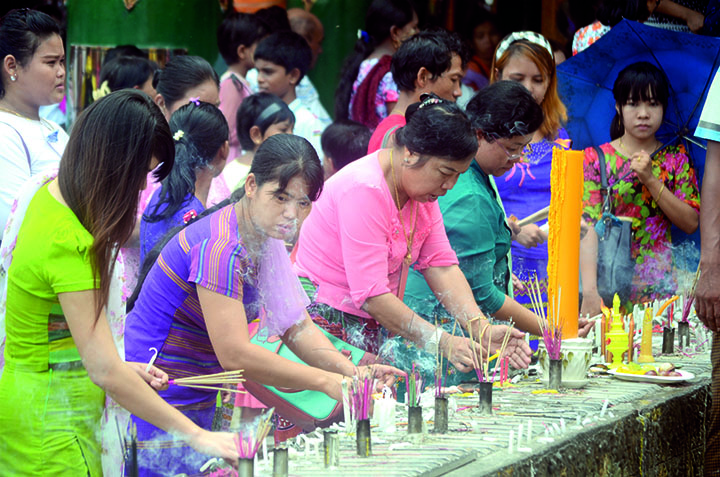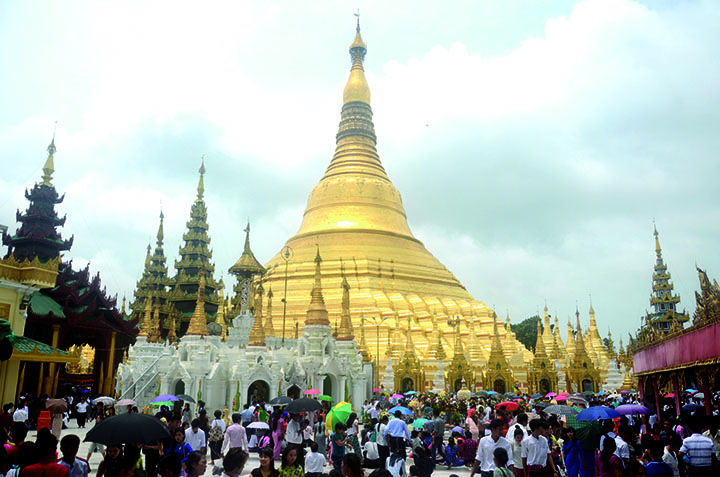The fourth month of Myanmar Lunar Calendar is Waso [July] the first month of rainy season in Myanmar [Wathan Kala] lasting three months. Waso, Wagaung and Tawthain [July, August and September respectively].
Waso’s astrological name is Kataka [Caneer] with the symbol of Crab. The queen flower of this month is Myat Lay [fragrant Jasminum grandi florum]. Depending upon the result of the yearly calculation of Myanmar Calendar Board, in some years there can be two Waso months—First Waso and Second Waso. Such two Waso year is known as Wa-htat year.
In old stone inscriptions Waso was called ”Nweta” meaning the month for measuring land. Before beginning of wet cultivation paddy and other grains farmers measure the extent of their fields or farms. But after Theravada Buddhism was introduced and wide spread across the country the month changed, to Waso of religious import.
Two words Wa and So have the same meaning wa is a Pali word Waso meaning ”to recite” or ”to say” or ”to tell”. ”So” is Myanmar word meaning to say. Loitering Buddhist monks accidentally or unknowing stepped on insects, or on crops in the fields destroying little creatures and spoiling cultivatin, and farmers, on seeing monks, stopped their work and paid respect to the monks and give offertories, their work was disturbed. When these happenings were reported to Lord Buddha he prescribed Rain Retreat of three months of cultivation period Waso, Wagaung and Tawthalin [July, August and September respectively] during which monks take the religious vows of not going out of the residential monasteries on pain of religious punishment.
On the first waning moon day of Waso all monks of the residing monastery gathered in the assembly hall with decorated altar of Buddha Statues. The Abbot or most senior monk leads the Waso rite and ceremony. By turn, every monk takes the vow in Pali as follows.
Imasmim vihare iman temasam vasam upemi meaning ”I shall stay in this monastery during the three months of rainy season”. Once, twice or three times, always followed by a chorus of Sadu [welldone] by the assembly. But due to unavoidable circumstances e.g. monk’s parents are sick or someone in the family passed away, the monk has to go home, he can ask for leave of absence not more than one week from the Abbot. Without that leave or overstay, the monk suffers the punishment ”Wakyo” [wa vow is broken]. He is not entitled to receive Kathein robe and his ordained years become invalid. He has to start again for his vasa [ordained years].
So Waso or rain retreat is Buddha’s way of preserving green environment. In Waso, Buddhists in Myanmar hold the festival of Waso robe offering to monks who need extra robe to change their wet robes. But traditional festival of Waso is the ordination festival. Only on reaching the age of 20 years, novices are allowed to be ordained as full-fledged monk. By now they are physically matured, mentally versed in character. With the permission of their parents, they are ordained. In the ordination hall they undergo the procedure of ordination-answering correctly, the questions by a chapter of five senior monks. Are you really man? Are you free from diseases, debt, Do you have permission from your parents, family or from your boss, Do you promise to abide by Vinaya [Disciplinary Rule for monks]. When the whole chapter agrees he is formally ordained.
The Ordination Festival in Waso is to recruit new blood into Sangha Order. Free choice for the ordained monk-either the remain ordained monk for life, for some years or for one day, one week or one month. Parents or donors of ordained monk and ordination become ”Inheritor of Buddha Sasana သာသနာ့ အမွေခံ၊ They were awarded by Myanmar Kings-such as immunity from taxation, hard labor military service and the right to prefix their names with Rahan daga Rahan Ama. Two ceremonial gold umbrellas shade their bodies at their funerals.
Four important events took place on the full moon of Waso in the life of Buddha. There is a Myanmar rhyme to tell these four events သန္ဓေ၊ တောထွက် ဓမ္မစက်၊ တချက် ဗျာဒိတ်ဟာ၊ Firstly, it was on the full moon day of Waso, Thursday that Prince Siddhartha was conceived in the womb of Maha Maya, Chief Queen of King Suddhodana of Kapilavatsu Kingdom. Secondly, it was on the full moon day of Waso, Monday that Prince Siddhartha at the age of 29 years after seeing four Omens, renounced his mundane life and left the palace to go into the forest to become a recluse searching for truth Dhamma. Thirdly, it was on the full moon day, of Waso, Saturday that the Lord Buddha gave his first sermon ”Dhammacakya” to the Five Recluses namely Kondanna, Vappa, Bhaddya Mahanan and Assaji in the Deer Park Migada wunna. Fourthly, it was on the full moon day Waso that Lord Buddha under the Mango Tree in the capital Sawutti showed his miracles to subdue the infields and herelies. A pair of water and fire coming out from the apertures of his head—eyes, ears, nostrils and mouth to subdue the in fields and herelies who now listned to Lord Buddha’s Dhamma. The Dhammacakya Day is also the Day of forming Sangha Order. The Five Recluses who became Arahats saint monks after hearing Anatha Lekkana Sutta delivered by Lord Buddha the following day formed the first Sangha Order.
Myanmar Buddhists celebrate Dhammacakya Day by group recitation of it and explanation of it by monks. Till today the above special events are observes and festivals are held, without fail. In that way Theravada Buddhism is preserved, promoted and propagated. Its socio-cultural impacts wellmaintained among Myanmar people regardless of race, religion and creed.




